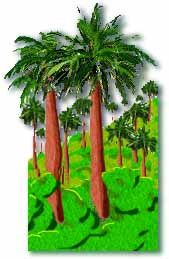 Why did all the trees
on Easter Island go away?
Why did all the trees
on Easter Island go away? Why did all the trees
on Easter Island go away?
Why did all the trees
on Easter Island go away?
This is the tragedy of our tale, for Easter Island truly is
the Land of the Lorax
Scientists looking at the soil layers on Easter Island show abundant plant and animal life dating back tens of thousands of years. There were many unique plants in Easter Island's forests when the first settlers arrived around 400 A.D.
In just a few generations
the people of Easter Island drove their plants and animals to extinction.
The greatest loss was the Easter Island Palm. The mature palm stood 80 foot tall. It's wood provided the hulls of the great sea canoes; it's sap produced a sweet syrup; and its palms yielded nutritious nuts. Until all the trees were harvested. When the last tree fell, the complex culture of Te Pito O Te Henua collapsed to chaos. The moai were abandoned, the ahu destroyed. The landlocked hunters and fishermen could not put to sea without their wooden canoes. The land became increasingly barren. In hunger, anger and despair the descendants of Hotu Matua turned on each other. A cruel irony on Easter Island is that the Polynesian word rakau - tree, wood, timber came to mean 'riches'. Dupetit-Thouars, an European sea captain who visited Easter Island in 1838, said that ten men in five leaky reed canoes visited his ship from the island. What they most wanted was wood. Even driftwood was looked on as a great treasure! A dying father's last words to his children would frequently be a promise to send back a tree from the kingdom of shade. Is this the inevitable result of limited resources on an isolated island? |
 |
Or can the mistakes and our knowledge of our histories save us and our natural riches?
Return to Easter Island main page.
main page.
copyright 2000 by The Learning Box
All Rights Reserved.